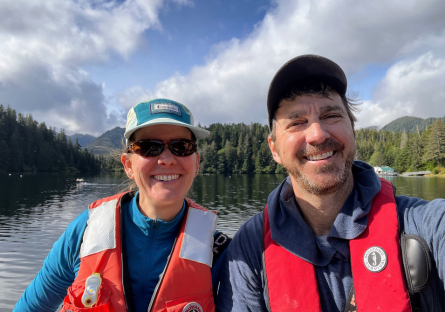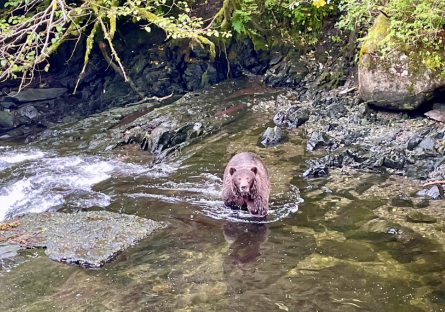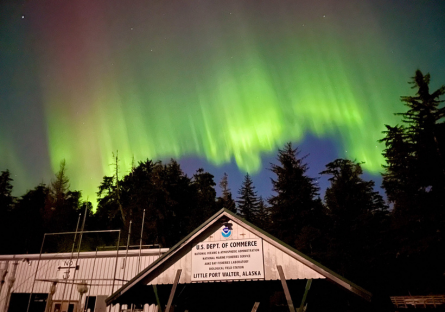





EMCC Marine Biology Professor Helps Manage Alaska Salmon Population
Give a man a fish (at NOAA’s Little Port Walter Research Station) and he’ll remove its coded wire tag, weigh it, measure it, clip one of its fins, and spawn it to create another generation. Such was the case for Estrella Mountain Community College (EMCC) Professor Dr. Jeff Miller who spent about two weeks at the Alaska research station on the Baranof Island last fall.
The EMCC Marine Biology professor got the chance to work at the research station through his membership in the Teacher at Sea Alumni Association, which is composed of more than 850 educators from across the U.S. who have successfully completed their National Oceanic and Atmospheric Administration (NOAA) Teacher at Sea Program research cruise. The Alumni Association provides its cohort of teachers with opportunities to interact and complete various professional development projects.
Dr. Miller was extremely excited to be chosen for this project because of his interest in fisheries and marine and freshwater ecology. When he’s not teaching his classes at EMCC, he’s mentoring EMCC’s underwater ROV, or Remotely Operated Vehicle, team and he’s volunteering with the National Park Service Native Fish Ecology and Conservation Program in the Grand Canyon.
“Volunteering with the program in the Grand Canyon has afforded me the ability to work with and learn a lot about fish and aquatic habitats,” he said.
It had also been 10 years since he’d been to Alaska on a family trip, and he wanted to go back.
“Put it all together and working with salmon in Alaska was a dream-come-true opportunity that I had to try,” he said.
He spent 12 days in September at Little Port Walter Research Station, which was established in 1934 and is the oldest year-round biological field station in Alaska. A whole lot of research goes on there, but the facility is also instrumental in Chinook salmon management under the Pacific Salmon Treaty, and that’s what Dr. Miller was there to help with.
Wild Chinook salmon start their lives in freshwater streams, estuaries, and associated wetlands and eventually move out to sea where they live anywhere from one to six years before they reach maturity and return to their places of origin to spawn and die. Little Port Walter captures the returning salmon and transfers them to saltwater holding pens until they are ready for spawning. Once they’re ready to spawn, they’re euthanized and scanned to determine if they have been marked with a tiny coded wire tag, which indicates that they came from a hatchery.
They are then weighed and measured to document their size, and a fin clip, which is used for genetic studies, is collected. Then the coded wire tag is removed so its data — hatchery of origin, age of the fish, etc. — can be collected.
“Given the extremely small size of the tag, this takes patience and a keen eye for detail,” Dr. Miller said.
Finally, the eggs and milt are retrieved and transferred to a hatchery where they are mixed to create the next generation of Little Port Walter Chinook salmon, enhancing wild populations for fisheries.
“Spawning days are busy and require a collaborative and focused effort from all participants,” Dr. Miller said. “The process is highly choreographed to facilitate quick and efficient collection of male and female gametes and data about each fish.”
The new generation of salmon leave the hatchery and return to Little Port Walter the following spring to continue growing while they acclimate to an ocean environment. They are then released into the ocean in the fall.
Dr. Miller said the highlight of the trip was being able to work with an amazing group of NOAA scientists as part of a dedicated team contributing to an important project.
“The experience changed how I perceived myself as a biologist and teacher,” he said. “As a biologist, my research focused on cell and molecular biology and I spent all my time indoors in a lab, but NOAA Teacher at Sea has provided amazing real-world experiences that I have used to learn more about fish and marine and freshwater ecosystems, and that has opened up an entire new world of biology for me to explore.”
As a teacher, Dr. Miller said he now has greater knowledge of and appreciation for the field of ecology and how human activities impact biological systems, which has helped him create new activities for his classes that he can use to better engage his students in scientific exploration and reasoning.
“Teaching through the lens of real-world experiences makes science education more relevant and engaging for students by connecting classroom learning to practical applications and everyday life,” he said. “Importantly, studies show that by incorporating real-world experiences into teaching activities, students from diverse backgrounds are more likely to engage with scientific concepts, gain scientific literacy and reasoning skills, develop a deeper understanding of STEM subjects, and become interested in pursuing science-related careers.”
Dr. Miller said he would like to use the knowledge and experiences he gained in Alaska to show how research and service can provide data that impacts policy and the power to facilitate restoration projects here in the Valley.
“Using salmon fisheries as the hook, I will help connect students to their communities and the world around them through meaningful, interdisciplinary experiences that help them think critically, collaborate, and design solutions to complex challenges,” he said.
Are you an educator who is interested in joining the Teacher at Sea Program? Learn more at https://www.fisheries.noaa.gov/topic/teacher-at-sea-program.